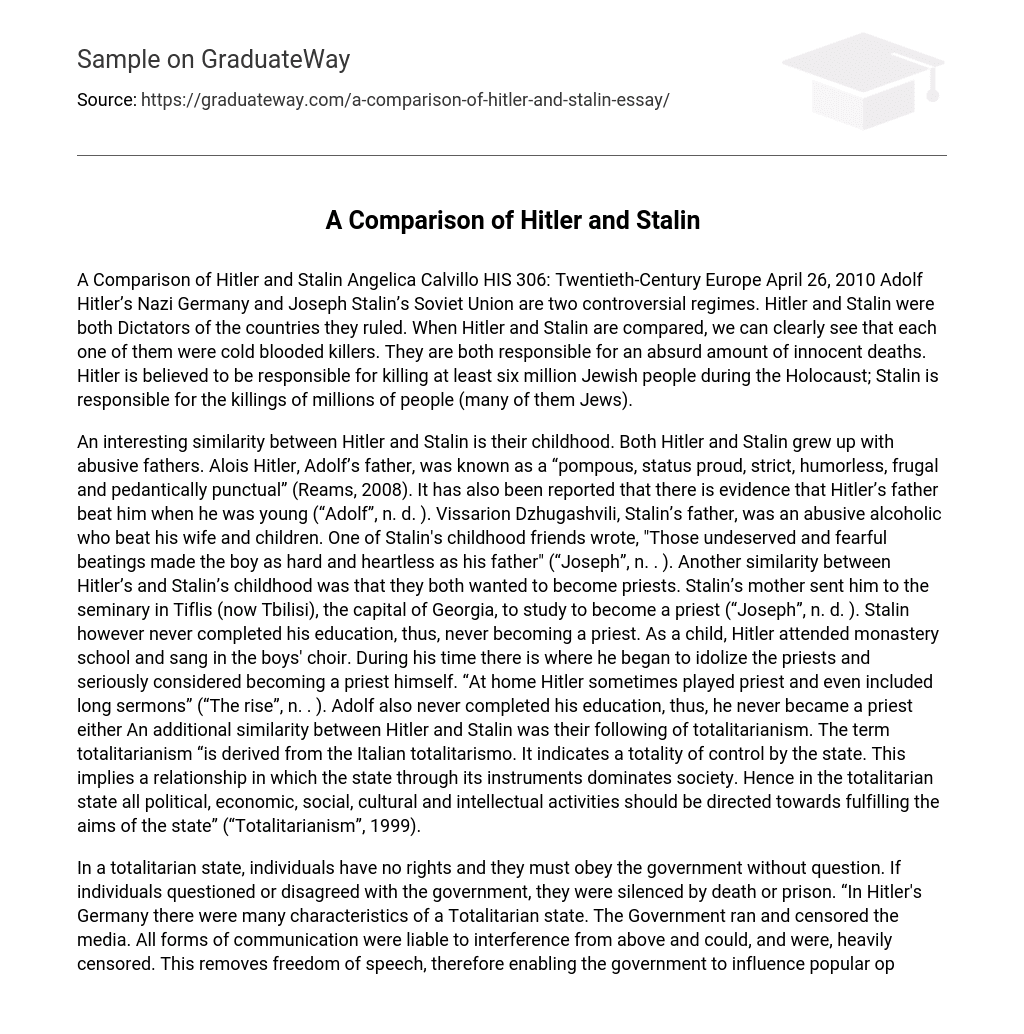Both Adolf Hitler and Joseph Stalin were dictators who led controversial regimes. They were responsible for the deaths of countless innocent lives, making them ruthless murderers. Hitler is believed to have killed at least six million Jews during the Holocaust, while Stalin caused the deaths of millions, including a significant number of Jewish individuals.
Both Hitler and Stalin had comparable childhoods, as they both grew up with abusive fathers. Adolf Hitler’s father, Alois Hitler, was characterized as “pompous, status proud, strict, humorless, frugal and pedantically punctual” (Reams, 2008). There are reports indicating that Adolf Hitler himself suffered physical abuse from his father during his early years (“Adolf”, n. d.). In a similar vein, Stalin’s father, Vissarion Dzhugashvili, was an alcoholic who frequently beat his wife and children.
Stalin’s childhood friend recounts that he became tough and unfeeling, similar to his father, after suffering from severe and unjust beatings (“Joseph”, n.d.). In a parallel way to Hitler’s ambitions, Stalin also had aspirations of becoming a priest. Consequently, his mother enrolled him in the seminary located in Tiflis (now known as Tbilisi), the capital of Georgia, for his religious instruction (“Joseph”, n.d.).
Although lacking education, Stalin did not choose to become a priest. In contrast, Hitler went to monastery school during his childhood and was part of the boys’ choir. This time in his life ignited Hitler’s strong admiration for priests and he seriously contemplated becoming one himself. According to “The rise,” Hitler would occasionally pretend to be a priest at home, even delivering lengthy sermons.
Adolf Hitler and Joseph Stalin had multiple similarities. Neither of them completed their education, which prevented Hitler from becoming a priest as well. They both adhered to totalitarianism, with the term originating from the Italian word totalitarismo, denoting complete state control over all aspects of society including politics, economy, social interactions, culture, and intellect, all serving the state’s objectives (“Totalitarianism”, 1999).
Individuals in a totalitarian state are devoid of rights and must unquestioningly obey the government. Dissent or disagreement with the government results in death or imprisonment. According to (“Was”, n. d.), Hitler’s Germany exhibited various characteristics of a Totalitarian state, such as government control and censorship of media and communication channels, thereby eliminating freedom of speech and allowing the government to shape public opinion through propaganda and dissemination of false news.
Stalin, like Hitler, used propaganda, censorship, and terror to impose his will on the Soviet people. The government newspapers praised work and glorified both Stalin and his rule. The secret police were tasked with monitoring citizens, and individuals who refused to show praise for Stalin and the state faced severe consequences, including death (source: “The Soviet”, n. d.). Prior to embracing a totalitarian approach, Hitler was associated with National Socialism, also known as Nazism. The term originates from the ideas of the Nationalsozialistische Deutsche Arbeiterpartei, a small party founded by Adolf Hitler (1889–1945) (source: “National”, 1999).
Both Hitler and Stalin were both practitioners of racism and anti-Semitism. They also both were not born in the countries they eventually ruled. Stalin, whose real name was Jozef Jughashvili, came from Georgia and not Russia, despite his Russian-sounding name “Stalin” derived from the Russian word for steel. Similarly, although ethnically German, Hitler was actually born in Austria instead of being a citizen of Germany at birth (“Hitler”, 2009). However, amidst these similarities between them, there were also notable differences. The most obvious distinction is that Hitler originated from Germany while Stalin came from Russia.
Hitler and Stalin communicated in different languages, with Hitler speaking German and Stalin speaking Russian. Moreover, they ascended to power through distinct methods. While Hitler attained power legitimately, he later invoked martial law following the destruction of the Reichstag, the German Parliament building. This incident signaled the commencement of a dreadful era during his reign. Exploiting his party’s dominance in the legislature, Hitler’s National Socialist Party enforced legislation that ultimately contributed to the collapse of his envisioned “1000 year Reich” (source: “Hitler”, 2009).
Unlike Lenin, Stalin ascended to power through a different route. Within the Bolshevik movement, which was founded on Karl Marx’s principles and guided by Vladimir Lenin and Leon Trotsky, Stalin held significant influence. Amidst the early 1920s when Lenin fell ill, Stalin craftily utilized his position in the Bolshevik Party to isolate Lenin from others and control all communication with him. Although largely relying on Stalin’s own narrative, it is widely acknowledged that Lenin expressed his preference for Stalin to assume leadership of the Bolshevik movement.
Although there are documents both supporting and opposing Stalin as Lenin’s successor, their credibility has always been in doubt (“Hitler”, 2009). It is unfortunate that the rule of these cruel dictators resulted in numerous lives lost. Nevertheless, an important lesson to be gleaned from these oppressive rulers is that dictatorship is an inappropriate form of government for any nation.
REFERENCES
- Adolf Hitler’s Childhood. (n. d. ). Think Quest. Retrieved April 24, 2010, from http://library. thinkquest. org/J0112264/Hitler1. html
- Hitler & Stalin: Contrast of Tyrannies. (2009). Associated Content. Retrieved April 24, 2010, from http://www. associatedcontent. com/article/1778292/hitler_stalin_contrast_of_ tyrannies. html
- Joseph Stalin (1879-1953). (n. d. ) PBS. Retrieved April 23, 2010, from http://www. pbs. org/redfiles/bios/all_bio_joseph_stalin. htm
- Joseph Stalin: Childhood and early years. (n. d. ). Spiritus-Temporis. Retrieved April 25, 2010, from http://www. spiritus-temporis. com/ joseph-stalin/childhood-and-early-years. html
- National Socialism. (1999). In The Blackwell Dictionary of Political Science. Retrieved from http://www. credoreference. com/entry/bkpolsci/national_socialism
- Reams, K. (2008, March 26). Adolf Hitler – The Child and Youth. Suite101. Retrieved April 24, 2010, from http://military-leaders. suite101. com/article. cfm/adolf_hitler_the_child_and_youth
- The rise of Adolf Hitler: Hitler’s Boy hood. (n. d. ). The History Place. Retrieved April 26, 2010, from http://www. historyplace. com/worldwar2/riseofhitler/boyhood. htm





